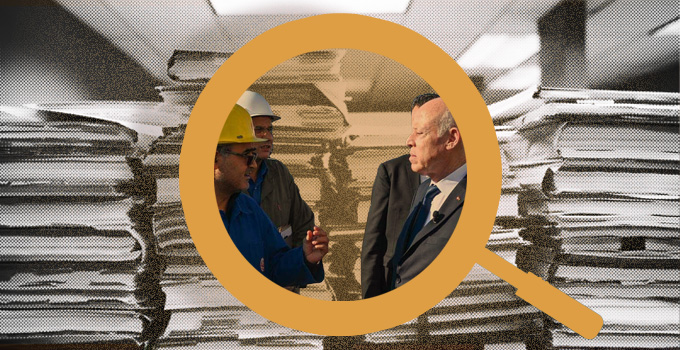What is the latest regarding Tunisia’s system of subsidies for basic commodities? More specifically, what is the current situation between the president and the government? In theory, this question has no place in the matter; both sides should be on the same page, especially since Kais Saied granted himself full power two years ago. As a result, the government no longer represents one of the executive’s two heads—the more important one—but rather a simple tool in the hands of the Carthage Palace’s current occupant. And so the question remains.

Everything appeared to be going along smoothly. That was, in any case, what official discourse projected about this thorny issue. Several months ago, a solution seemed to have materialized, a means to alleviate the increasingly heavy burden that Tunisia’s subsidy system has come to represent for the State budget.
The idea was to create a platform to organize the distribution of subsidies for basic commodities to families in need. The platform should already have been up and running over five months ago. But authorities swiftly abandoned this version and opted for another in which citizens who consider themselves in need were to register themselves. Today, there is no talk of either option. In fact, just as the groundwork for this project was to be nearing completion in the beginning of December 2022, Saied declared—for the first time—his opposition to removing subsidies on basic goods.
At first, it was reasonable to believe that the president’s remarks did not signify a complete change of course on the issue. Doubt began to settle in as the project to create a platform fell by the wayside. And yet, according to the previous minister of commerce, Fadhila Rabhi (in a speech on January 4, 2023, just two days before her dismissal), the platform was to become effective the same month, or February 2023 at the latest. Doubt became certainty, however, when President Saied pulled out of his sleeve an alternative solution that no one had anticipated: the creation of a new tax to be paid by Tunisians who benefit unduly from subsidies on essential goods.

A project fallen by the wayside
What could possibly account for this turnaround on such a sensitive issue? At the present stage, in the absence of any official explanation, two hypotheses are plausible. The first: divergences between the president and the government are the effect of a division of roles designed to give Tunisia leverage in negotiations with the International Monetary Fund (IMF). In support of this theory, a source who wishes to remain anonymous confirms that the State has previously employed this strategy in the context of other issues.
Second hypothesis: divergences between the president and the government—whose members were selected and appointed by Saied himself—are real and not simulated.
The first scenario seems more likely for several reasons. Most importantly, several State institutions have worked on this issue, whether independently or in partnership with multilateral financing institutions such as the African Development Bank (ADB) and the World Bank.
In fact, efforts to reform the subsidy system have long roots. For years, the policy of subsidizing basic goods was not problematic. Initiated with the creation of the General Compensation Fund (CGC) in 1970, the policy was consolidated in the mid-1980s. With the Structural Adjustment Program rendered inevitable by the economic and financial crisis of 1986, the State was forced to create the Assistance Program for Needy Families (PNAFN) to offset painful economic structural reforms.
The number of beneficiaries rose over time, from 124,000 in 2010, to 268,000 by December 2021. The cost of the program steadily increased as well. This was particularly true after January 14, 2011, since the first governments following the Ben Ali regime—the government headed by Beji Caid Essebsi, then the two Troika administrations led by Hamadi Jebali and Ali Laarayedh respectively—did not cut corners on all kinds of public expenditures, enabling them to buy social peace. It was at this moment when authorities began to raise the question: how to keep basic goods accessible to the average Tunisian and at the same time reign in out of control budgetary spending on subsidies?
Two initial studies, «Food subsidies and direct social aid: Improving the targeting of income poverty and hardship in Tunisia» and «Evaluation of the social assistance program and the challenges of parallel economy», published in March and April 2013 respectively, were prepared by the Center for Research and Studies in the Social Sciences (CRES) and funded by the African Development Bank.
A similar investigation was launched several months later. In 2014, the National Statistics Institute (INS) and CRES (also with sponsor funding) analyzed «the impact of food subsidies and social assistance programs on Tunisia’s poor and vulnerable».
In 2020, the same CRES—this time with funding from the World Bank—completed a second study with the objective of «identifying poor and vulnerable households in Tunisia».
In 2021, the Tunisian Institute of Strategic Studies (ITES), affiliated with the presidency, completed a study focused on how to «strengthen food security in Tunisia in 2022-2023».
Finally, the Tunisian Institute of Competition and Quantitative Studies (ITCEQ) published a study on «Reforming the targeting of food subsidies». The analysis developed by the ITCEQ, which operates under the Ministry of Economy and Planning, is perhaps the most thorough and so useful as a reference to inform the debate at the national level, and, especially, at the State level.
And although the ITCEQ is not opposed to the removal of subsidies—indeed, the Institute deems this necessary—it considers that this reform alone is not enough to achieve the desired objectives.
According to the ITCEQ, the subsidy system suffers from certain weaknesses, particularly in relation to governance. This is why, despite decreasing prices for most basic commodities on the global market over the past several years, subsidies have gradually increased in Tunisia. As a percentage of the GDP, subsidies rose from 1.3% during the period of 2003-2010, to 1.8% throughout 2011-2017.

Additionally, «the General Compensation Fund’s subsidy system is extremely inequitable in so much as it tends to subsidize the consumer habits of the ‘non-needy’ far more than and indeed at the expense of ‘the needy’.» Finally, «a portion of subsidies is exploited by non-household consumers through the illegal use of subsidized products for certain activities (bakeries, hotel and restaurant establishments, etc.)».

Poor governance of the subsidy system
The diagnostic thus presented, the study suggests three scenarios. A first «basic scenario» without any reforms, and two others based on «targeting through the direct transfer of subsidies to households». The second, «central scenario», takes place over three years. The third, a more gradual scenario, would take place over five years.
Favorable to the idea of change, the authors of the study suggest taking advantage of the «stabilization of basic food commodities in global markets» to pursue a reform trajectory that is gradual. This approach allows for the introduction of respite phases as the country makes the transition towards true prices. This should enable categories of the population that do not benefit from direct subsidies to replenish their reserves.
Nevertheless, the authors warn, reform is likely to impact households and certain sectors. Households will endure «significant losses in purchasing and consumer power». Certain heavily-subsidized agro-food activities, such as those relating to the transformation of wheat, «are likely to witness decreased profitability and thus decreased activity and employment across these sectors».

A «resting phase» in the midst of reform
Which is the best bet for Tunisia’s reform trajectory? The study’s authors advance several recommendations. The first is to stagger, over a period beyond three years, the dismantling of the current subsidy system and the implementation of a new system of direct transfers. In the meantime, this process must also take into account the «risk of trend reversals in global markets for the concerned commodities».
In order to offset the «initial effects of reform on the job market», the second scenario proposes «rethinking the essence and scope of social safety nets as a means to accompany this reform». At this stage we can imagine, for instance, the implementation of mechanisms for guaranteed income using a portion of savings on compensation expenses, the promotion of «worker employability through skill upgrades», and providing support in the transformation of sectors whose profitability are likely to decrease following this reform.
Finally, rather than settling for the distribution of targeted assistance, the study recommends sustaining reforms through investments that aim to «improve the quality and efficiency of basic public services such as public transportation, health, education, etc.»
This approach «can have more sustainable results in terms of reducing the cost of living than would direct income transfers». Moreover, the study argues, « nternational experience clearly shows that the programs which made a successful transition to targeted subsidies were based largely on transfers conditional on performance in these services».
If, under the impetus of President Saied, Tunisia were to continue to dig its heels in against reforming the current subsidy system, it would be one of the rare countries to do so. One need look no further than our Maghreb neighbors to see this.
In spite of its tremendous petroleum and gas revenues, Algeria elected to eliminate subsidies for basic commodities at the end of 2021. Morocco intends to do the same over a two-year period, beginning in 2024. Libya is in the midst of a debate around the issue. The country initially discussed lifting hydrocarbon subsidies in 2014, but ultimately abandoned the idea.
Today, the plan is back on the table and Libya is considering taking the leap. Mauritania has yet to take steps in this direction. In fact, Mauritania’s subsidies have increased slightly over the past two years, accounting for 2.1% of the country’s GDP in 2021 and 2% in 2020. Unlike Tunisia, however, Mauritania managed to set up a national registry to enable the targeted distribution of social assistance.







iThere are no comments
Add yours